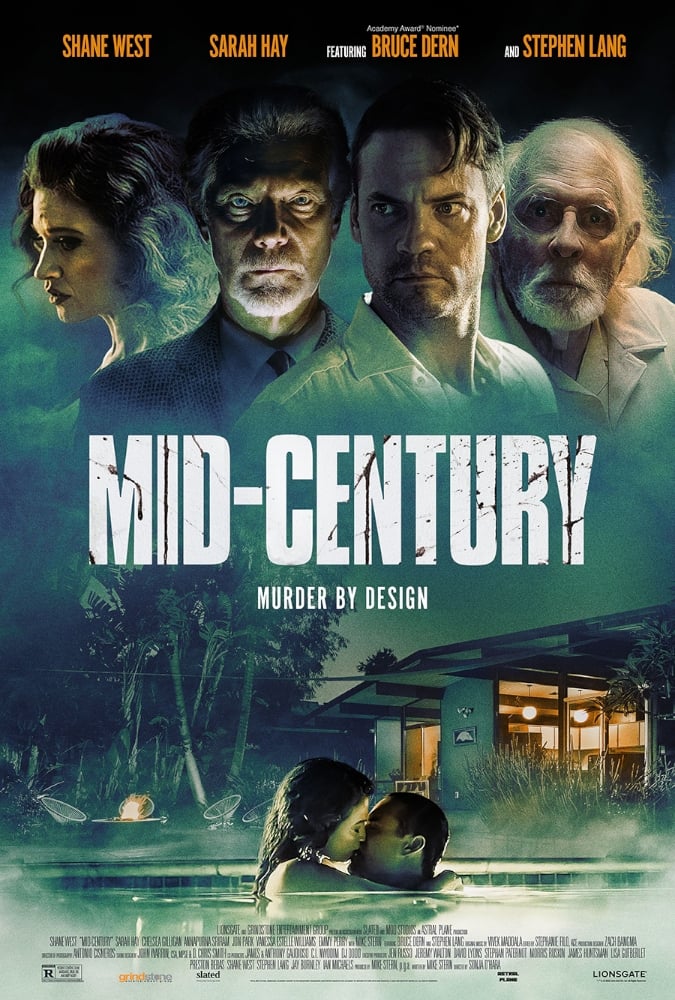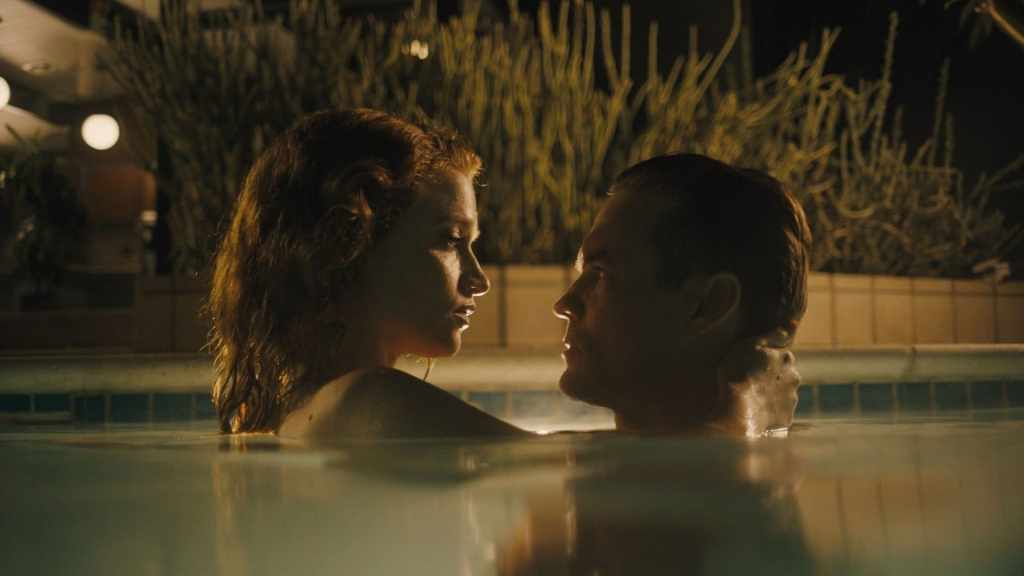
Mid-Century was directed by Sonja O’Hara, written by Mike Stern, and stars Shane West, Chelsea Gilligan, Sarah Hay, Emmy Perry, Mike Stern, Stephen Lang, and Bruce Dern. It’s about a couple who are besieged by the past remnants of the vacation house they’ve rented for the weekend.
The Plot: It’s hard to tell what Stern was going for with his script, as it can’t be asked to commit to one facet of its own story, bringing in genre elements across multiple timeframes to get to a conclusion that does somewhat satisfy, but is only announced after a jarring first 65 minutes.
In 1963, famed architect Frederick Banner (Lang) stops by to visit a couple who’ve moved into one of his contemporary homes. All isn’t what it seems though, as he has sinister intentions for the new owners. In the present, married couple Tom (West) and Alice (Gilligan) arrive at that same house for a weekend stay. They settle in just fine, ordering food and chilling out, but life goes on – for some reason – as Alice still has to go to work; wouldn’t that just be housesitting? Why would you rent a house for the weekend and not use it to its full extent?
With his wife at work, Eldridge (Stern) kills their delivery man, and odd things start to happen, like doors opening by themselves, audience-only views of apparitions, and bumps in the night. Getting curious, Tom calls on his assistant Hannah (Perry) to investigate Frederick’s life, which includes painter Emil (Dern) and “the Brotherhood of the Orange King” which sought immortality. Stern throws all of this kind of information at the audience but never goes back to stitch it together into a cohesive hole. If it has something to do with the blood moon that’s going to occur during the weekend, why Marie (Hay) who helps Tom investigate, is the only ghost out of many murders, why she can communicate with Tom before a certain point, and so forth, are all unanswered questions.
These elements lead the movie towards a shifty third act that’s annotated by flashbacks to Banner, which aren’t surprising thanks to the fact that the movie started out with his encroaching on house owners. It touches base with other side characters and subplots, but Mid-Century’s story is too unfocused and unsatisfying because of this.
The Characters: While the writer was busy trying to create a vast mythos for the story, he forgot to create characters of any kind, leaving the actors stranded without relationship details in a movie that wanted to be at least partially about the dichotomy between men and women.
Tom and Alice have been struggling, with the man having to put his own architectural planning on hold to visit the rented house with his wife. Like the plot, he’s conflicted, as his ongoing affair with Hannah is threatened by his wife’s desire to move into a house in the same neighborhood. Even still, he wants a family, even though Alice doesn’t. There are so many of these disagreements between them that their marriage feels forced to allow the movie to touch the surface of themes but dare not go deeper.
Some of the first few scenes in the present day showcase the woman’s ongoing suffering at the hands (literally) of her male coworker, and one of her female coworkers is trying to help her get a new position at a different hospital closer to her ideal home and without harassment. Her career as a doctor and her trauma aren’t utilized in the story though, making this feel pointless in the grand scheme.
Banner was a man with a polygamist lifestyle that stretched across several decades and, like Alice’s own tormentors, women, who in Banner’s case always wound up dead or missing. Again, Stern doesn’t fill in the blanks beyond blatant misogynism. Did the Brotherhood make him into a monster? If so, was it through coercion or free will? Who knows? A roster of characters like this doesn’t make room for connections between or for them; they’re just kinda there.

The Horror: Most of the moments intended to scare the audience don’t land at all. In fact, each individual scene or sequence devoted to startling Tom and the audience just raises even more questions.
Scenes in the past illustrate Frederick’s murderous actions, from strangling one of the people who bought a house he designed, to slaying his own wife just a room over from their son. They’re unsettling due to Lang’s mannered performance as a man so demanding that he can be set off by the slightest reference to him outside of his presence. His ability to swiftly change attitudes depending on who’s around him is menacing as well, but this would’ve been much more impactful if the movie didn’t open by revealing this as being a major component of his lifestyle.
Occult and spiritual connections between the house, Frederick, Tom, and the blood moon are all insinuated over the course of the movie, but they aren’t elaborated on. I’d say the script bends its own rules to scare the audience with nebulous powers, but that would imply there were rules to begin with. Some doors open by themselves, and objects are moved around but for some reason the ghost of Marie doesn’t do the digging she wants Tom to do. Phone lines go out at some times but not at others, Tom sees a vision of the past one time and never again, and so forth.
A twist occurs in the second third of Mid-Century, which again forces a 90 degree turn that does answer some questions and introduce a point to all of the preceding events but pokes a continuity error involving the death of a main character and a meat hook, and again feels like it comes out of spontaneous script development. The cult does finally come into play, and its followers’ plan is sinister, but after said reveal, the power dynamic shifts to a point where one of the main characters is in control instead of the villain, removing tension.
Moments of shock do arise, mostly from Lang’s strong performance, but the movie is often more puzzling than scary.
The Technics: Mid-Century does a good job at encapsulating different eras with minimal funding and scale and has decent direction to boot.
O’Hara had only directed one other feature before this, but she has a competent grasp around constructing a full-length movie. Most of the lasting impact comes from production designer Zach Bangma and set decorator Layla Kornota’s dressing and redressing of the same location to give the house two different feelings, but O’Hara never makes any amateurish moves aside from the opening set in the past that ruffles the reveals in the present.
Makeup effects and post-production changes are passable too. Wounds on bodies are shown in detail and look good enough, but some brightening of the image done after filming and a blurry filter pressed over top of the scenes set in the past are questionable since everything else looks much better with significantly less tinkering.
Straddling too many characters and ideas causes a skimp on scares in Mid-Century. It’s well acted and produced but gets way too caught up in its own misshapen story to do much aside from beguile.
36/100
Misc details
Release date (US): October 24, 2022
Distributor: Lionsgate Films
Runtime: 105 minutes
MPAA rating: R


Leave a comment